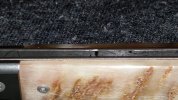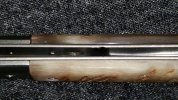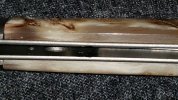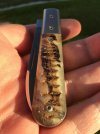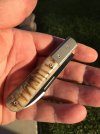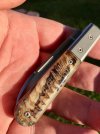NJBillK
Custom Leather and Fixed Blade modifications.
- Joined
- Mar 27, 2014
- Messages
- 9,594
I notice some folks saying that the light showing in between the liners and spring is a F&F issue, and I don't think it is (entirely).
Hear me out.
If you look into the blade well with the blade open, you will see that the liners are flush at the butt of the handle. But due to the space needed for the washers, there is a gap up front. This gap is the same width as the washers, and the only reason it is there.
If they did not use washers, they could have had this as tight as a GEC blade, but possibly not be as smooth from the beginning. Our knives do not require a break in, due to the washers. As they wear, we can actually tighten them up a bit due to the pivot construction. This will keep them feeling "factory tight" for a longer period of time.
Now, to agree that this can still be considered a F&F issue, yes, they could have used a thinner blade stock to make up for the added thickness of the washers, or used thicker liners and milled them to cup the washer slightly, but each of these "fixes" would have added their own issues.
A) Thinner blade stock = not matching the spring thickness = less eye appeal and a less stout blade.
B) Thinner spring to match the thinner blade stock, i.e. both being the same thickness = same set up as we are currently in = gap.
C) Thicker milled liners = more labor and more costs that would have to be pushed onto the customer = a more expensive knife. Some folks were already a bit dismayed by the slight bump due to exchange rate changes.
After thinking about this for a little bit, I am absolutely fine with the give and take that there is between what we received from what we paid. I can give a bit of a gap to keep the pivot adjustable and maintain the feel of the knife (presumably) two, three, five plus years down the line.
Hear me out.
If you look into the blade well with the blade open, you will see that the liners are flush at the butt of the handle. But due to the space needed for the washers, there is a gap up front. This gap is the same width as the washers, and the only reason it is there.
If they did not use washers, they could have had this as tight as a GEC blade, but possibly not be as smooth from the beginning. Our knives do not require a break in, due to the washers. As they wear, we can actually tighten them up a bit due to the pivot construction. This will keep them feeling "factory tight" for a longer period of time.
Now, to agree that this can still be considered a F&F issue, yes, they could have used a thinner blade stock to make up for the added thickness of the washers, or used thicker liners and milled them to cup the washer slightly, but each of these "fixes" would have added their own issues.
A) Thinner blade stock = not matching the spring thickness = less eye appeal and a less stout blade.
B) Thinner spring to match the thinner blade stock, i.e. both being the same thickness = same set up as we are currently in = gap.
C) Thicker milled liners = more labor and more costs that would have to be pushed onto the customer = a more expensive knife. Some folks were already a bit dismayed by the slight bump due to exchange rate changes.
After thinking about this for a little bit, I am absolutely fine with the give and take that there is between what we received from what we paid. I can give a bit of a gap to keep the pivot adjustable and maintain the feel of the knife (presumably) two, three, five plus years down the line.


